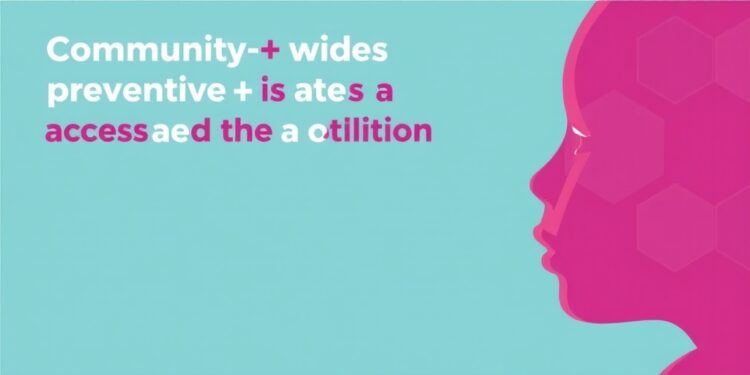In a groundbreaking study published in JAMA Pediatrics, researchers have reported a significant reduction in both substantiated and unsubstantiated cases of child sexual abuse through a coordinated, place-based intervention at the county level. The study highlights the efficacy of strategic public health initiatives designed to address and mitigate child abuse in communities. By integrating various resources and support systems, the program aims to create a protective environment for children, thereby lessening the incidence of abuse.
Child sexual abuse is a persistent and devastating problem that affects countless young lives. In the past, various strategies have been employed to combat this issue, but the current study suggests that a comprehensive, coordinated approach can yield significantly better outcomes than traditional interventions. By leveraging local resources and involving multiple stakeholders—such as schools, community organizations, and law enforcement agencies—the program offers a more robust response to the challenge of child abuse.
The research conducted by Dr. Jennie G. Noll and her team emphasizes the importance of not only addressing incidents of abuse after they occur but also implementing preemptive measures that can deter such behavior from taking root. One of the core strategies proposed in this intervention was to enhance community awareness and education about the signs of child abuse, thereby empowering community members to report concerns and seek help. This proactive stance has the potential to not only prevent abuse but also foster a community culture of vigilance and support.
An intriguing aspect of this study is the differentiation between substantiated and unsubstantiated cases of abuse. By tracking the reduction in both categories, the researchers were able to demonstrate that intervention can create a safer environment for children while also leading to a decrease in false allegations. The data presented in the study paint a compelling picture of how targeted initiatives can generate substantial changes in public health metrics and child safety outcomes.
The implications of such findings are far-reaching. With child protection concerns constantly evolving, this study presents a template for other regions seeking to implement similar interventions. Policymakers and public health officials can draw on these findings to develop their own county- or community-wide programs, tailoring strategies to reflect local needs and resources while uniting various sectors in a concerted effort to protect children.
In addition to community-driven initiatives, the study also emphasizes the importance of ongoing training for professionals who work with children. Educators, healthcare providers, and social workers all play a crucial role in identifying potential abuse and intervening when necessary. By equipping these individuals with the knowledge and tools they need to recognize warning signs, the likelihood of preventing abuse significantly increases.
Furthermore, the study’s findings can help inform future research by establishing a clear link between coordinated community interventions and decreases in child sexual abuse. More comprehensive studies could build on this foundation, exploring additional variables such as socioeconomic factors, demographic influences, and the role of technology in reporting abuse. The ability to harness data from future implementations could lead to even more effective intervention strategies.
The evaluation of this program’s effectiveness not only underscores the need for concrete action plans but also reinforces the importance of community participation in safeguarding vulnerable populations. Each individual plays a critical role in fostering an environment where children feel safe and supported, which can ultimately reduce the risks associated with abuse.
Collaboration is key in the success of any intervention. The current study showcases how cross-sector partnerships can amplify the effects of child protection measures. By bringing together diverse stakeholders, programs can tap into a wealth of expertise, resources, and community insights, ultimately leading to more innovative and effective strategies against child abuse.
As the findings unfold, they prompt further discussion on the role of public health in child welfare. It is essential for public health officials not only to promote physical well-being but also to ensure emotional and psychological safety for children in the community. Addressing the complex, interrelated factors contributing to child abuse requires a holistic approach that includes education, outreach, and policy reform.
This study also serves as a wake-up call to various sectors that have a stake in child welfare. Local governments, non-profit organizations, and community leaders need to recognize the potential impact they have in preventing child abuse through collaborative efforts. By pooling resources, knowledge, and hard work, communities can make strides toward significantly lowering incidence rates of child sexual abuse.
As the research community digests the implications of this study, future developments will likely focus on scaling successful intervention models and adapting them to different geographic and cultural contexts. The landscape of public health is ever-changing, and this study paves the way for innovative solutions to persistent public health challenges, such as child abuse.
This evaluation ultimately reaffirms that collective action can lead to a marked decrease in child sexual abuse. It stands to reason that as educators, health practitioners, and community members build stronger networks of support, children will thrive in safer, more nurturing environments. With continued research and community engagement, a future where children are protected from sexual abuse is not only possible but achievable.
Subject of Research: Coordinated community intervention to reduce child sexual abuse
Article Title: Evaluation of a Countywide Intervention to Reduce Child Sexual Abuse
News Publication Date: October 2023
Web References: [Link Placeholder]
References: [Link Placeholder]
Image Credits: [Link Placeholder]
Keywords: Child sexual abuse, public health, community intervention, prevention strategies, children’s welfare, collaborative efforts, JAMA Pediatrics, coordinated care, child protection.
Tags: child sexual abuse reduction strategiescommunity resources for child protectioncommunity-wide prevention initiativescomprehensive approaches to child welfarecoordinated response to child abuseeducational programs on child abuse preventionJAMA Pediatrics research findingslong-term impact of abuse prevention programsplace-based interventions against child sexual abuseprotective environments for childrenpublic health interventions for child safetystakeholder involvement in abuse prevention





